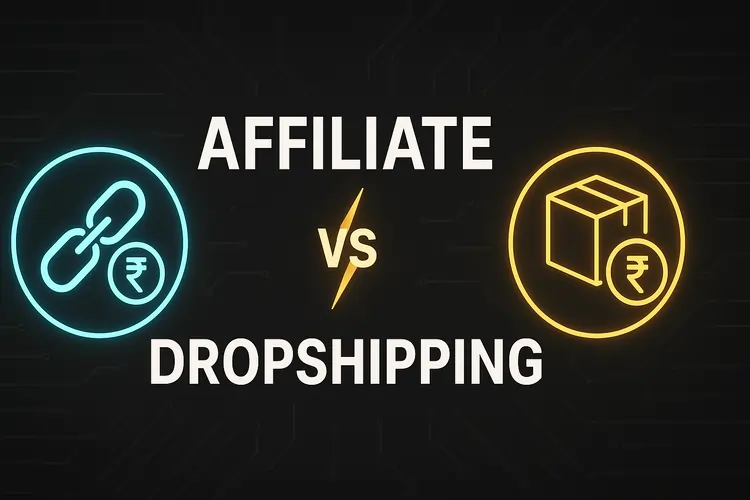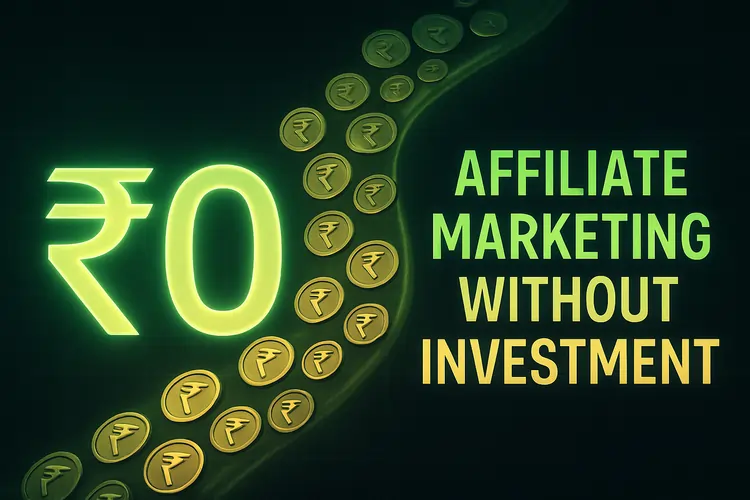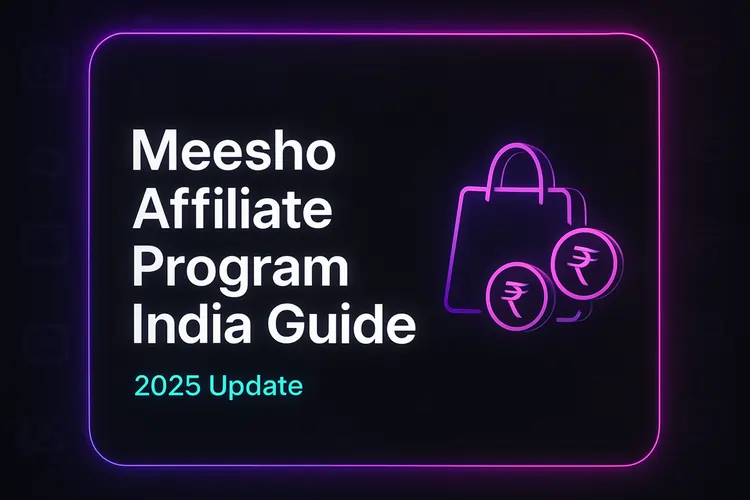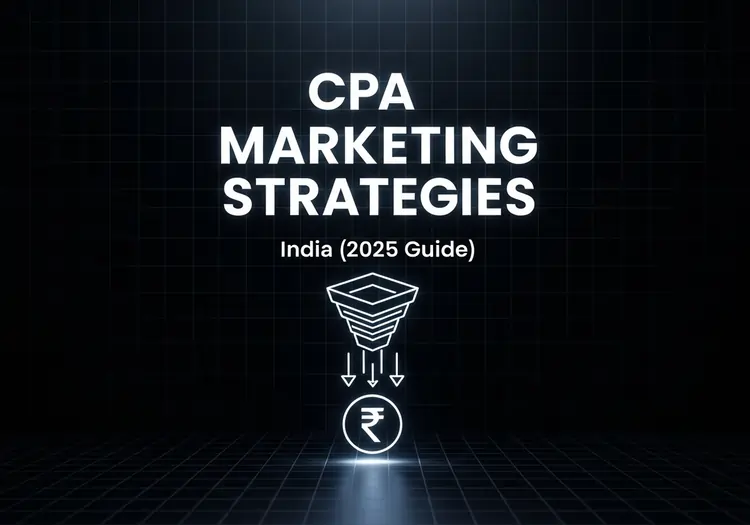In 2025, many Indian entrepreneurs face the same crossroad: affiliate marketing vs dropshipping. Both promise online income, but the path, effort, and payoff differ sharply. Choose wrong and you’ll waste months chasing thin margins. Choose right and you can scale profitably with clarity.
India’s e-commerce wave is massive — projected to cross ₹8 lakh crore by 2027 (IAMAI, 2024). In this environment, knowing whether to promote products as an affiliate or sell through dropshipping isn’t just theory. It’s the difference between surviving and thriving as a digital entrepreneur.
At The DM School, a Google Partner that has trained 1 Lakh+ students, we’ve seen both models succeed — but only when applied with the right strategy. This post gives you a step-by-step breakdown to decide what works best in India.
What is affiliate marketing vs dropshipping?
Affiliate marketing vs dropshipping compares two proven models of online business. Affiliates promote products for a commission, while dropshippers sell products without ever holding inventory, keeping the profit margin on each order.
Affiliate marketing definition: You drive traffic using a unique link, and when a customer buys or takes an action, you get paid. You never own the product or deal with shipping. This model is popular in India through platforms like Amazon Associates, Flipkart, and finance/edtech affiliate networks.
Dropshipping explained: You run an online store, list products, and when a customer orders, the supplier ships directly to them. You set the price, pay the supplier, and keep the margin. Indian entrepreneurs often partner with suppliers on Shopify, Meesho, or Qikink to run low-investment e-commerce businesses.
| Dimension | Affiliate Marketing | Dropshipping |
|---|---|---|
| Role | Promoter / publisher | Store owner / retailer |
| Inventory | No inventory | No inventory (supplier handles) |
| Costs | Low setup; traffic spend | Store apps, ads, support |
| Revenue | Commission per sale/lead | Margin = Price − Supplier cost |
| Control | Low product control | Control on price & offers |
| Ops load | Light; content + tracking | Medium; orders + support |
Want practical starting points? See Affiliate programs in India or learn how to build a low-cost Shopify site for dropshipping.
Summary: Affiliates earn commissions by promoting products; dropshippers run a store, set prices, and profit from margins without inventory.
Now you can explain both models confidently to anyone in one line.
Why affiliate marketing vs dropshipping matters in India in 2025
The choice between affiliate marketing vs dropshipping is not theory anymore—it’s shaping how Indian entrepreneurs earn online. Both models ride on India’s e-commerce boom, which is projected to cross ₹8 lakh crore by 2027 (IAMAI, 2024). But the opportunity curve is different for each.
Affiliate marketing gives you access to established platforms like Amazon, Flipkart, and edtech networks. You don’t need inventory or customer service, making it a low-barrier entry for beginners. On the other hand, dropshipping lets you control pricing and brand positioning. You can build your own Shopify or Meesho-powered store and capture higher margins, but at the cost of operations and support.
Global affiliate marketing is worth over US$32 billion in 2024, growing at 19% CAGR to 2032 (Shopify, 2024). India’s dropshipping market is also expanding fast, projected to grow at 25% annually (Qikink, 2024). The decision you make today determines if you’ll rely on commissions or margins in the coming years.
For a deeper playbook on digital growth, see our Digital Marketing Funnel guide to connect the right model with long-term customer journeys.
Summary: Both affiliate marketing and dropshipping matter because India’s e-commerce is booming, but each model offers different control and risk levels.
Now you understand why choosing the right model is critical in India’s fast-growing online market.
Core elements of affiliate marketing vs dropshipping
To compare affiliate marketing vs dropshipping, you need to break down the core elements that drive revenue, control, and workload. Both models look simple on paper, but the way you earn and manage operations is very different.
Affiliate Marketing: Core Elements
- Traffic source: Blogs, YouTube, Instagram, paid ads.
- Commission structure: Usually 5–15% per sale (Shopify, 2024).
- Operational load: Content creation + tracking links.
- Risk: Low—no refunds, no shipping issues.
Dropshipping: Core Elements
- Store setup: Shopify, WooCommerce, or Meesho storefront.
- Margin range: Typically 20–40% after supplier costs (Shopify, 2024).
- Operational load: Order management + customer support.
- Risk: Medium—delivery delays, refund handling, supplier reliability.
When you line them up, the trade-off is clear: affiliates rely on steady affiliate vs dropshipping pros cons decisions, while dropshippers build a brand but accept higher ops load.
For entrepreneurs seeking predictable income with minimal management, affiliate is often the safer entry. For those chasing brand equity and bigger margins, dropshipping offers more upside.
Explore how both models tie into an end-to-end growth path in our Digital Marketing Funnel guide.
Summary: Affiliate marketing focuses on traffic and commissions; dropshipping centers on store margins and customer operations.
Now you can map the exact elements that define each model before making a choice.
Strategic factors to consider before choosing affiliate marketing vs dropshipping
When deciding on affiliate marketing vs dropshipping, strategy matters more than surface-level comparisons. Both models can make money, but long-term sustainability depends on scalability, risks, and market conditions in India.
- Scalability: Affiliate income grows with audience reach. Dropshipping scales with paid ads, but higher order volume means heavier support load.
- Competition: Affiliate niches like finance and education are crowded. Dropshipping faces saturation in trending products and rising ad costs.
- Regulation: Affiliates must follow advertising standards and platform rules. Dropshippers must manage GST, returns, and shipping compliance in India.
- Brand value: Affiliates build authority but not brand equity. Dropshipping lets you create your own brand presence.
- Profit stability: Affiliate commissions depend on program rules. Dropshipping margins can shrink with supplier price changes or tariffs (sticky.io, 2024).
Reality check: many Indian entrepreneurs start dropshipping for margins but switch to affiliate or hybrid models when support pressure grows.
See how disciplined funnels overcome these challenges in our Ad Process for Digital Marketing India playbook.
Summary: Strategic factors like scalability, regulation, and brand goals decide whether affiliate marketing or dropshipping is the better fit.
Now you can weigh strategy, not just surface numbers, before choosing your path.
Tools & frameworks for Indian creators
To win at affiliate marketing vs dropshipping, you need the right tools and frameworks. Without systems, both models quickly become messy. The good news—India now has platforms that simplify execution for beginners and advanced players alike.
Affiliate Marketing
- Networks: Amazon Associates, Flipkart, Admitad.
- Tracking tools: Bitly, Voluum, Google Analytics.
- Content engines: WordPress + SEO plugins.
- Framework: Attract → Educate → Recommend → Commission.
Dropshipping
- Storefronts: Shopify, WooCommerce, Meesho integrations.
- Supplier tools: Qikink, GlowRoad.
- Payment gateways: Razorpay, PayU.
- Framework: Attract → Nurture → Convert → Retain.
The Growth Flywheel™ connects both models. Affiliates attract with content; dropshippers attract with ads. Both must nurture leads via email/WhatsApp, convert with sharp offers, and retain with consistent engagement. Master this cycle and scale becomes predictable.
Check our Email Automation Beginner’s Guide to strengthen the nurture stage in this flywheel.
Summary: The right tools and a clear Growth Flywheel™ framework decide whether affiliate marketing or dropshipping grows steadily in India.
Now you can choose platforms and apply the flywheel to scale with confidence.
India-specific 90-day plan: launch affiliate marketing vs dropshipping
Success with affiliate marketing vs dropshipping doesn’t come from random action. You need a clear 90-day roadmap. Here’s how an Indian entrepreneur can realistically launch either model step by step.
| Timeline | Affiliate Marketing | Dropshipping |
|---|---|---|
| Days 1–30 | Pick 1–2 niches, join Amazon/Flipkart affiliates, set up WordPress blog or YouTube channel. | Set up Shopify/WooCommerce store, register GST if needed, shortlist 5 suppliers (Qikink, GlowRoad). |
| Days 31–60 | Publish 10+ content pieces, run low-budget SEO or ads, test which offers convert. | List 20–30 products, run test ads on Meta/Google, optimize product pages for CTR. |
| Days 61–90 | Build email list, integrate automation, aim for first ₹25K–₹50K commission milestone. | Refine winners, improve delivery & support, aim for ₹50K–₹1 lakh in net sales margin. |
Reality check: most Indian affiliates start seeing traction around 60 days, while dropshippers need 90 days for stability due to supplier and ad optimization cycles.
To scale beyond the first 90 days, see our Digital Marketing Strategy from Scratch guide.
Summary: A disciplined 90-day plan helps beginners launch affiliate or dropshipping businesses in India with realistic milestones.
Now you can map your first 3 months clearly instead of guessing.
Q: What is affiliate marketing vs dropshipping?
Affiliate marketing vs dropshipping compares two business models. Affiliates promote products through unique links and earn a commission on each sale or lead. Dropshippers create their own online store, list products without inventory, and profit from the margin after paying suppliers who ship directly to customers.
Q: Which is more profitable in India, affiliate marketing or dropshipping?
Dropshipping often yields higher profit per order—margins can reach 20–40%—but it requires upfront ad spend, GST compliance, and supplier management. Affiliate marketing has lower barriers and steady growth potential, but commissions are smaller (5–15%). Profitability depends on skills: affiliates need strong content/SEO, while dropshippers need reliable suppliers and ad optimization.
Q: How much money do I need to start dropshipping in India?
Most beginners need ₹20,000–₹50,000 to launch a dropshipping business in India. This budget covers Shopify or WooCommerce store setup, GST registration if required, payment gateway integration, sample product testing, and initial advertising. Success also depends on negotiating with suppliers on platforms like Qikink or GlowRoad to maintain healthy margins.
Q: Do I need GST registration for affiliate marketing in India?
For most Indian affiliates, GST is not mandatory at the start. If your annual commission income stays below ₹20 lakh, you can operate without GST. Once your earnings cross this threshold, or if you work with brands that demand GST invoices, registration becomes essential for tax compliance and future scalability.
Q: Can affiliate marketing and dropshipping be combined?
Yes, many Indian entrepreneurs run hybrid models. For example, they use dropshipping to sell physical products while simultaneously promoting affiliate offers via blogs, YouTube, or email lists. This combination allows them to diversify income streams—commissions from affiliates and profits from margins—without relying solely on one model or platform’s rules.
Q: Is dropshipping legal in India in 2025?
Yes, dropshipping is completely legal in India. However, you must comply with GST rules for taxable turnover, follow consumer protection laws, and ensure customer-friendly refund policies. Choosing trustworthy suppliers is crucial, since late deliveries or poor quality can lead to chargebacks and damage your reputation. Compliance keeps the model sustainable long-term.
Q: How long does it take to earn from affiliate marketing in India?
On average, Indian affiliates start seeing first commissions in 30–60 days. Those who publish consistent YouTube videos, write SEO blogs, or run paid ads can hit ₹10K–₹25K per month within 3–6 months. Sustainable growth depends on picking profitable niches, driving quality traffic, and reinvesting earnings into content and marketing channels.
Q: How to start affiliate marketing vs dropshipping in India?
To start affiliate marketing, sign up with programs like Amazon Associates, Flipkart, or Indian fintech/edtech networks, and build a blog or channel. For dropshipping, launch a Shopify or WooCommerce store, find reliable suppliers on Meesho/Qikink, and run targeted ads. Both models need consistent traffic strategies—content for affiliates, and ads for dropshippers.
Conclusion: Choosing affiliate marketing vs dropshipping in India
At the end of the day, affiliate marketing vs dropshipping isn’t about which is “better,” but which fits your current stage. If you want a low-risk entry and steady growth, affiliate marketing is a clear start. If you’re ready to manage suppliers and build a store brand, dropshipping offers higher upside.
Both models thrive when backed by the right digital marketing system. At The DM School, a Google Partner that has trained over 1 Lakh students, we’ve seen how disciplined funnels, smart targeting, and consistent follow-ups turn either model into a reliable income stream.
Summary: Affiliate marketing is easier to start, while dropshipping offers higher margins with higher responsibility. Your choice should align with skills, capital, and patience.
Now you’re ready to make a confident decision and start your journey.
Ready to start your online business?
Don’t waste time guessing. Work with India’s #1 Google Partner agency for a proven roadmap to success.
- Get expert guidance on affiliate marketing and dropshipping.
- Access funnels and scripts that close sales faster.
- Scale with confidence using real-world case studies.


